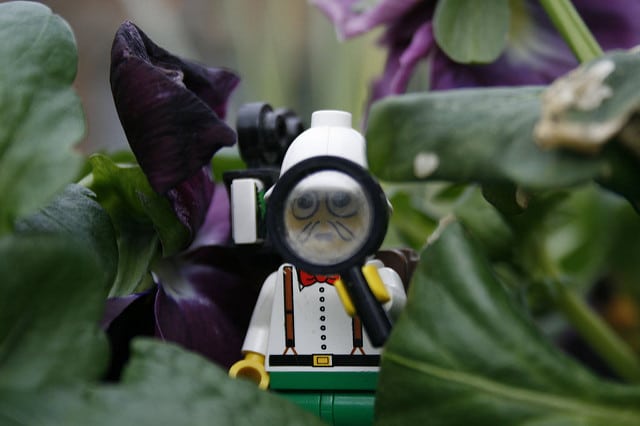If you’ve been keeping up with our recent series of articles, welcome back! If not, you can catch up on how fluorescence works or what not to do with your flow experiment. In short, we have been discussing fluorescent labels and their role in flow cytometry.
Today, I’ll round out our discussion by touching on where we’ve been. I’ll also introduce some exciting new directions the field is headed in.
The History of Fluorescent Labels
Before we begin, we must, like any good scientist, know where we started to understand the magnitude of change.
When flow cytometry was first widely used in the early 1970s, flow cytometers possessed only one laser and two light detectors. One detector for forward scatter (measure of cell size) and one for fluorescence. Initially, there were also only two fluorescent labels used: fluorescein (the backbone of the derivative fluorescein isothiocyanate, or FITC) and rhodamine. Now, most machines contain 4 lasers. With the help of filters you can now detect up to 16 fluorophores!
One of the main focuses of fluorescence as it relates to flow cytometry is to produce as many fluorescent labels as possible. The result is simple: the more original dyes available that do not overlap on the emission spectra, the more variety of cellular antigenic markers you can detect at one time–an immunologist’s dream!
Nature Has the Answer
But where to find these fantastic dyes? What better place to look than in nature! Indeed, in 1983, Vernon Oi, along with the help of Alex Glazer and Lubert Stryer labs, began isolating phycobiliproteins from cyanobacteria and certain algae. These water-soluble proteins function in nature to capture light energy and pass it to chlorophylls during photosynthesis. Basically, the perfect fluorophores. The effort of these scientists led to the isolation of two of the most commonly used fluorescent labels still used today: phycoerythrin (PE) and allophycocyanine (APC).
Not long after the successful use of PE and APC, scientists wondered how to get even more bang for their buck. Enter tandem dyes. We have covered the concept and technology behind tandem dyes more in depth, so I will not be addressing that again. The development of tandem dyes built upon PE and APC, which continue to be the basis for several tandem dyes. This includes PE-Cy7 and APC-Cy7 and allows more access to the fluorescent spectra.
In more recent history, the introduction of Alexa Fluor dyes provided an alternative dye that is more stable, brighter, and less pH-sensitive compared to some of the more common dyes. Fun fact: the family of Alexa Fluor dyes were adorably named after the son of the founders of the producing company Molecular Probes, Inc. Finally, in 2011, Brilliant Violet dyes were brought to the market with the ability to expand the amount of fluorescent options in the violet laser. So many colors!
The Future
So where does this leave the future of fluorescent molecules and their use in flow cytometry? Surprisingly, there are still quite a few explored areas that scientists are beginning to investigate.
Increasing Stability
One of the major setbacks for a lot of dyes currently on the market is instability of fluorophores resulting from either light or heat exposure, or both. To remedy this, several fluorophore families have been developed to remedy these issues. For instance, BioLegend has recently welcomed PE/Dazzle 594 as an alternative for PE-Texas Red/ECD with the claim of “exceptional photostability.” As previously mentioned, BioLegend developed a series of dyes that belong to the Brilliant Violet family. These dyes are actually a huge improvement over a lot of the organic dyes we’ve been discussing. You can learn more about them at BioLegend’s website.
Expanding the Spectrum
However, in my opinion, the most exciting addition to the fluorophore toolbox is definitely Brilliant UV dyes, part of the BD Horizon group from BD Biosciences. Previously, UV lasers were restricted in their utility, and primarily used for detecting DNA/RNA binding fluorophores like DAPI. Researchers at BD Biosciences looked at this, thought “what a waste!”, and got to work. The outcome is a bunch of antibodies directly conjugated to fluorophores that are excited by the UV laser. They’re not perfect by any means because some of them are expected to spill over into other detectors. But the fact that there is a possibility to add 6 more colors to a flow cytometry staining panel is a huge step.
There is no doubt that future R&D by these companies will be focused on making these fluorophores more stable by every parameter, and likely even looking into more nano-particle based chemistry. Stay tuned!
And so ends our series on fluorescent labels and how they fit into flow cytometry. I hope you’ve enjoyed all the topics we’ve discussed, as I’ve had a great time putting it all together. Before I get called out on it, to try to focus I have purposefully left out such topics as quantum dots, although this has been covered in our Microscopy Channel. Also, there is a great article on the history of flow cytometry and a different article on the history of fluorescent labels (which also includes dots) that already exist at Bitesize Bio. Go check ‘em out!
Further Reading
- https://www.clinchem.org/content/48/10/1819.long
- www.biolegend.com
- www.bdbiosciences.com







